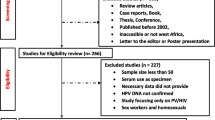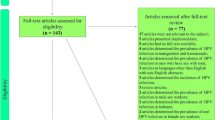Abstract
Human Papillomavirus (HPV) is the most important risk factor for cervical cancer, although not the only one. The allelic polymorphism of enzymes acting on carcinogen metabolism has shown to influence the risk of both intraepithelial lesions and cervical carcinogenesis. Several studies found an association between GSTM1/GSTT1 null genotypes and risk of cancer. This research aimed to review studies addressing the relationship between GSTT1 and GSTM1 and HPV infection in women, with or without cervical pathologies. A database search was conducted in four databases – PubMed, LILACS, SciELO, and Virtual Health Library – using the following descriptors: Glutathione transferase, HPV, and Genetic polymorphism. In total, we found 319 studies. After screening titles and abstracts, 27 articles were selected for full-text read, among which 20 were excluded and 7 were included in the review. No study has exclusively approached the relationship between the virus and GSTM1/GSTT1 variants. However, studies investigating the association between single nucleotide polymorphisms (SNPs) and cervical lesions or cancer found a probable relationship between them and infections with high-risk oncogenic subtypes. Although inconclusive, GSTT1 null alleles were more common in women with more aggressive HPV than GSTM1.

Similar content being viewed by others
References
Patel H, Wagner M, Singhal P, Kothari S (2013) Systematic review of the incidence and prevalence of genital warts. BMC Infect Dis 13(1):39. https://doi.org/10.1186/1471-2334-13-39
Bray F, Ferlay J, Soerjomataram I, Siegel RL, Torre LA, Jemal A (2018) Global cancer statistics 2018 GLOBOCAN estimates of incidence and mortality worldwide for 36 cancers in 185 countries. CA Cancer J Clin 68(6):394–424
Gomes IN de CJA. Estimativa 2020: Incidência de câncer no Brasil [Internet]. Rio de Janeiro: INCA; 2019. Available from: https://www.inca.gov.br/sites/ufu.sti.inca.local/files/media/document/estimativa-2020-incidencia-de-cancer-no-brasil.pdf.
Crosbie EJ, Einstein MH, Franceschi S, Kitchener HC (2013) Human papillomavirus and cervical cancer. Lancet 382(9895):889–899. https://doi.org/10.1016/S0140-6736(13)60022-7
Bosch FX, Lorincz A, Munoz N, Meijer CJLM, Shah KV (2002) The causal relation between human papillomavirus and cervical cancer. J Clin Pathol 55(4):244–265. https://doi.org/10.1016/s0168-1702(02)00187-9
Guan P, Howell-Jones R, Li N, Bruni L, de Sanjosé S, Franceschi S et al (2012) Human papillomavirus types in 115,789 HPV-positive women: a meta-analysis from cervical infection to cancer. Int J cancer 131(10):2349–2359. https://doi.org/10.1002/ijc.27485
Centers for Disease Control and Prevention (CDC). CDC - STDs - HPV. 2015;Available from: https://www.cdc.gov/std/hpv/default.htm.
Schiffman M, Castle PE, Jeronimo J, Rodriguez AC, Wacholder S (2007) Human papillomavirus and cervical cancer. Lancet (London, England) 370(9590):890–907. https://doi.org/10.1016/S0140-6736(07)61416-0
Castellsagué X, Bosch FX, Muñoz N, Meijer CJLM, Shah KV, de Sanjosé S et al (2002) Male Circumcision, Penile Human Papillomavirus Infection, and Cervical Cancer in Female Partners. N Engl J Med 346(15):1105–1112
Gadducci A, Barsotti C, Cosio S, Domenici L, Riccardo GA (2011) Smoking habit, immune suppression, oral contraceptive use, and hormone replacement therapy use and cervical carcinogenesis: a review of the literature. Gynecol Endocrinol 27(8):597–604
Waggoner SE, Darcy KM, Tian C, Lanciano R (2010) Smoking behavior in women with locally advanced cervical carcinoma: a Gynecologic Oncology Group study. Am J Obstet Gynecol 202(3):283.e1-283.e7
Siokos AG, Siokou-Siova O, Tzafetas I (2019) Correlation between cervical carcinogenesis and tobacco use by sexual partners. Hell J Nucl Med 22(Suppl 2):184–190
Pudney J, Quayle AJ, Anderson DJ (2005) Immunological microenvironments in the human vagina and cervix: mediators of cellular immunity are concentrated in the cervical transformation zone1. Biol Reprod 73(6):1253–1263. https://doi.org/10.1095/biolreprod.105.043133
Lôpo SS. Correlação entre infecção genital por papilomavírus humano (HPV) e imunidade em mulheres infectadas pelo vírus linfotrópico de células T humanas tipo-1 (HTLV-1). Dissertação, Escola Bahiana de Medicina e Saúde Pública. [Internet]. Bibl. Digit. Bras. Teses e Diss. 2006 [citado 2020 set 17];82. Available from: https://bdtd.ibict.br/vufind/Record/CRUZ_a7a35ef4ddad316800581b548defbb0b
Cruz-Gregorio A, Manzo-Merino J, Lizano M (2018) Cellular redox, cancer and human papillomavirus. Virus Res 246:35–45
Cseh J, Pázsit E, Orsós Z, Marek E, Huszár A, Balogh S et al (2011) Effect of glutathione-S-transferase M1 and T1 allelic polymorphisms on HPV-induced cervical precancer formation. Anticancer Res 31(9):3051–3055
Nunobiki O, Ueda M, Akise H, Izuma S, Torii K, Okamoto Y et al (2015) GSTM1, GSTT1, and NQO1 polymorphisms in cervical carcinogenesis. Hum Cell 28(3):109–113. https://doi.org/10.1007/s13577-015-0111-9
Hayes JD, Flanagan JU, Jowsey IR (2005) Glutathione transferases. Annu Rev Pharmacol Toxicol 45(1):51–88
Anantharaman D, Chaubal PM, Kannan S, Bhisey RA, Mahimkar MB (2007) Susceptibility to oral cancer by genetic polymorphisms at CYP1A1, GSTM1 and GSTT1 loci among Indians: tobacco exposure as a risk modulator. Carcinogenesis 28(7):1455–1462. https://doi.org/10.7314/apjcp.2015.16.15.6429
Palma S, Novelli F, Padua L, Venuti A, Prignano G, Mariani L et al (2010) Interaction between glutathione-S-transferase polymorphisms, smoking habit, and HPV infection in cervical cancer risk. J Cancer Res Clin Oncol 136(7):1101–1109. https://doi.org/10.1007/s00432-009-0757-3
Sharma A, Gupta S, Sodhani P, Singh V, Sehgal A, Sardana S et al (2015) Glutathione S-transferase M1 and T1 Polymorphisms, Cigarette Smoking and HPV Infection in Precancerous and Cancerous Lesions of the Uterine Cervix. Asian Pac J Cancer Prev 16(15):6429–6438
Malik SS, Kazmi Z, Fatima I, Shabbir R, Perveen S, Masood N (2016) Genetic polymorphism of GSTM1 and GSTT1 and risk of prostatic carcinoma - a meta-analysis of 7,281 prostate cancer cases and 9,082 healthy controls. Asian Pacific J Cancer Prev 17(5):2629–2635
Pacholak LM, Amarante MK, Guembarovski RL, Watanabe MAE, Panis C (2020) Polymorphisms in GSTT1 and GSTM1 genes as possible risk factors for susceptibility to breast cancer development and their influence in chemotherapy response: a systematic review. Mol Biol Rep 47(7):5495–5501
Moher D, Liberati A, Tetzlaff J, Altman DG (2009) Preferred Reporting Items for Systematic Reviews and Meta-Analyses: The PRISMA Statement. PLoS Med. https://doi.org/10.1371/journal.pmed.1000097
Lee S-A, Kim JW, Roh JW, Choi JY, Lee K-M, Yoo K-Y et al (2004) Genetic polymorphisms of GSTM1, p21, p53 and HPV infection with cervical cancer in Korean women. Gynecol Oncol 93(1):14–18. https://doi.org/10.1016/j.ygyno.2003.11.045
Ueda M, Hung Y-C, Terai Y, Saito J, Nunobiki O, Noda S et al (2005) Glutathione-S-transferase and p53 polymorphisms in cervical carcinogenesis. Gynecol Oncol 96(3):736–740. https://doi.org/10.1016/j.ygyno.2004.11.005
Ueda M, Toji E, Nunobiki O, Sato N, Izuma S, Torii K et al (2010) Germline polymorphisms of glutathione-S-transferase GSTM1, GSTT1 and p53 codon 72 in cervical carcinogenesis. Hum Cell 23(4):119–125. https://doi.org/10.1111/j.1749-0774.2010.00089.x
Sudenga SL, Shrestha S, Macaluso M, Partridge EE, Johanning GL, Piyathilake CJ (2014) Functional variants in CYP1A1 and GSTM1 are associated with clearance of cervical HPV infection. Gynecol Oncol 135(3):560–564. https://doi.org/10.1016/j.ygyno.2014.09.015
Kim JW, Lee CG, Park YG, Kim KS, Kim I-K, Sohn YW et al (2000) Combined analysis of germline polymorphisms of p53, GSTM1, GSTT1, CYP1a1, and CYP2e1. Cancer 88(9):2082–2091
Benabdelkrim M, Djeffal O, Berredjem H (2018) GSTM1 and GSTT1 polymorphisms and susceptibility to prostate cancer: a case-control study of the algerian population. Asian Pac J Cancer Prev 19(10):2853–2858
da Silva CN, da Silva DN, Moraes KL, Cordeiro JABL, Brasil VV, Saddi VA et al (2015) GSTM1 and GSTT1 genes null polymorphisms in kidney cancer susceptibility: evidence based on a meta-analysis. J Bras Nefrol 37(2):248–254. https://doi.org/10.5935/0101-2800.20150038
Wei Y, Zhou T, Lin H, Sun M, Wang D, Li H et al (2013) Significant associations between GSTM1/GSTT1 polymorphisms and nasopharyngeal cancer risk. Tumor Biol 34(2):887–894. https://doi.org/10.1007/s13277-012-0623-9
Liu K, Lin X, Zhou Q, Ma T, Han L, Mao G et al (2014) The Associations between Two Vital GSTs Genetic Polymorphisms and Lung Cancer Risk in the Chinese Population: Evidence from 71 Studies. PLoS ONE 9(7):e102372. https://doi.org/10.1371/journal.pone.0102372
He H-R, You H-S, Sun J-Y, Hu S-S, Ma Y, Dong Y-L et al (2014) Glutathione S-transferase gene polymorphisms and susceptibility to acute myeloid leukemia: meta-analyses. Jpn J Clin Oncol 44(11):1070–1081
Sui C, Ma J, He X, Wang G, Ai F (2014) Interactive effect of glutathione S-transferase M1 and T1 polymorphisms on hepatocellular carcinoma. Tumour Biol 35(8):8235–8241. https://doi.org/10.1007/s13277-014-2071-1
Sengupta D, Guha U, Mitra S et al (2018) Meta-analysis of polymorphic variants conferring genetic risk to cervical cancer in Indian women supports CYP1A1 as an important associated locus. Asian Pac J Cancer Prev 19(8):2071–2081
Hayes JD, Pulford DJ (1995) The glutathione S-transferase supergene family: regulation of GST and the contribution of the isoenzymes to cancer chemoprotection and drug resistance. Crit Rev Biochem Mol Biol 30(6):445–600. https://doi.org/10.3109/10409239509083491
Tian S, Yang X, Zhang L, Zhao J, Pei M, Yu Y et al (2019) Polymorphic variants conferring genetic risk to cervical lesions support GSTs as important associated loci. Medicine (Baltimore) 98(41):e17487. https://doi.org/10.1097/MD.0000000000017487
Pett M, Coleman N (2007) (2007) Integration of high-risk human papillomvirus: a key event in cervical carcinogenesis? J Pathol 212(4):356–367. https://doi.org/10.1002/path.2192
Wongworawat Y, Filippova M, Williams VM, Filippov V, Duerksen-Hughes PJ (2016) Chronic oxidative stress increases the integration frequency of foreign DNA and human papillomavirus 16 in human keratinocytes. Am J Cancer Res 6(4):764–780
Chen C, Nirunsuksiri W (1999) Decreased expression of glutathione S-transferase M1 in HPV16-transfected human cervical keratinocytes in culture. Carcinogenesis 20(4):699–703. https://doi.org/10.1093/carcin/20.4.699
Rebbeck TR (1997) Molecular epidemiology of the human glutathione S-transferase genotypes GSTM1 and GSTT1 in cancer susceptibility. Cancer Epidemiol Biomarkers Prev 6(9):733–743
Funding
No funding was received for conducting this study.
Author information
Authors and Affiliations
Contributions
For transparency we inform that all authors performed the literature search and data analysis, drafted and critically revised the work. Ana Paula Reolon Bortolli and Léia Carolina Lucio had the idea for the article.
Corresponding author
Ethics declarations
Conflict of interest
All authors declare that they have no conflict to interest.
Consent to participate
All authors informed consent.
Consent to publish
All authors approved the version to be published and agree to be accountable for all aspects of the work in ensuring related to the accuracy or integrity of any part of the work are appropriately investigated and resolved.
Additional information
Publisher's Note
Springer Nature remains neutral with regard to jurisdictional claims in published maps and institutional affiliations.
Rights and permissions
About this article
Cite this article
Bortolli, A.P.R., Vieira, V.K., Stefanski, E.E. et al. Relationship between GSTM1 and GSTT1 polymorphisms and HPV infection: a systematic review. Mol Biol Rep 48, 6631–6636 (2021). https://doi.org/10.1007/s11033-021-06515-6
Received:
Accepted:
Published:
Issue Date:
DOI: https://doi.org/10.1007/s11033-021-06515-6




